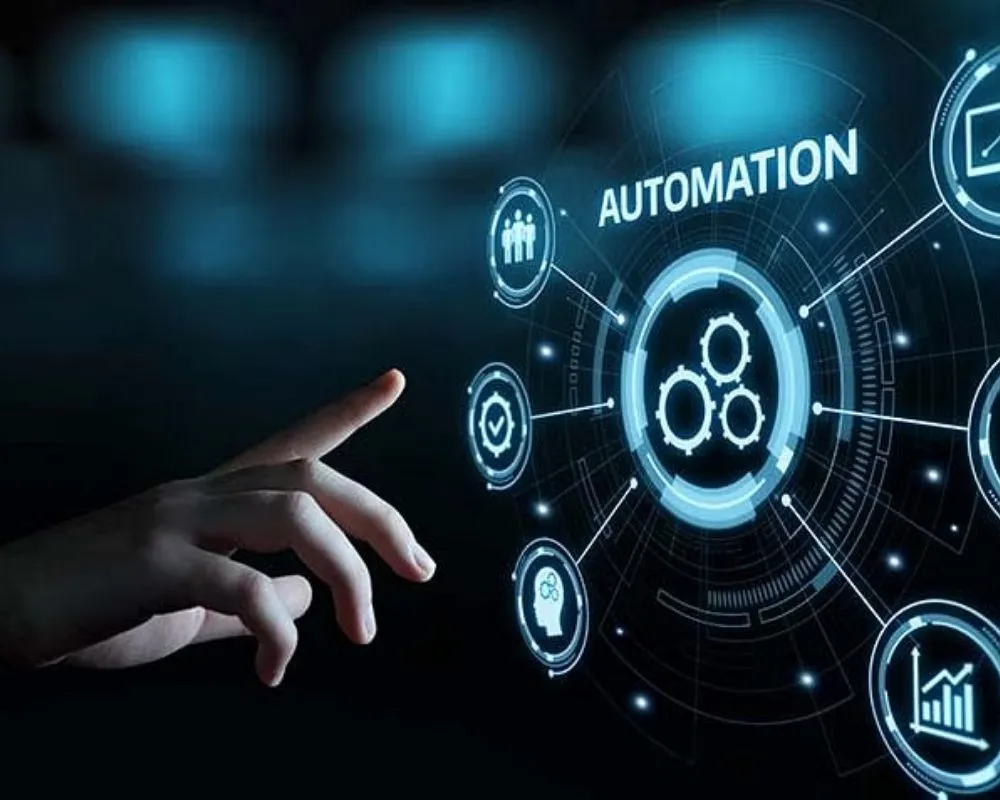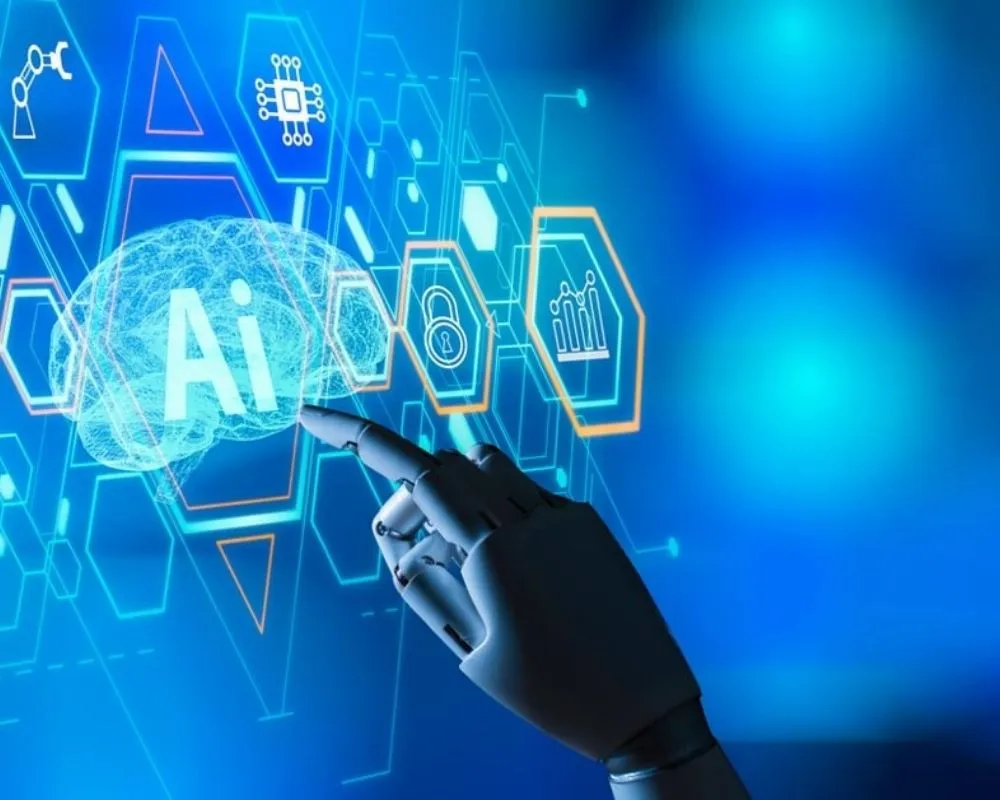In the era of digital transformation, automation is no longer a choice. Moving beyond RPA or workflow automation, the concept of Hyperautomation has emerged as a major breakthrough — integrating Artificial Intelligence (AI), Robotic Process Automation (RPA), Machine Learning (ML), and various other advanced technologies.
This article provides a clear understanding of the concept, analyzes its application potential, and introduces several representative case studies — particularly from BAP Software’s practical implementation perspective.

Hyperautomation là bước tiến vượt bậc của công nghệ số. Nguồn: Akabot
1. What is Hyperautomation?
1.1. Official Definition by Gartner
According to Gartner,
“Hyperautomation refers to the use of a combination of advanced technologies such as Artificial Intelligence (AI), Robotic Process Automation (RPA), Machine Learning (ML), and other technologies to enhance business process automation, far beyond the capabilities of traditional automation.”
This means that instead of using robots merely to handle repetitive tasks, Hyperautomation aims for comprehensive automation, encompassing complex, cross-departmental processes that require adaptability and real-time decision-making capabilities.
1.2. Comparison: Traditional Automation vs. Hyperautomation
| Criteria | Traditional Automation | Hyperautomation |
|---|---|---|
| Technologies Used | Mainly RPA | RPA + AI + ML + NLP + iPaaS… |
| Application Scope | Single, predefined tasks | End-to-end processes across departments and systems |
| Decision-making Ability | Rule-based | Self-learning, context-aware adaptation |
| Scalability | Limited | High – can autonomously expand scope of operation |
| Example | Robot inputs data from Excel into CRM | System analyzes customer behavior and automatically suggests personalized care strategies |
While traditional automation focuses on eliminating repetitive tasks, Hyperautomation goes further by building a “digital nervous system” that enables enterprises to analyze, act, and continuously improve — creating long-term strategic value.
1.3. Core Technologies Behind Hyperautomation
Hyperautomation represents the convergence of multiple modern technologies, forming a fully automated and intelligent system, including:
RPA (Robotic Process Automation): The foundational technology that performs repetitive tasks such as data entry, information extraction, and system updates.
AI (Artificial Intelligence): Enables systems to understand context, process natural language and images, and make data-driven decisions.
Machine Learning (ML): Enhances system self-learning and optimization based on new data over time.
Process Mining: Analyzes system log data (ERP, CRM, etc.) to discover and optimize real business processes.
iPaaS (Integration Platform as a Service): Integrates multiple systems such as CRM, ERP, chatbots, and email into a seamless automated flow.
Low-code / No-code Platforms: Allow rapid workflow creation and customization without complex coding.
NLP (Natural Language Processing): Enables systems to understand and interact with users via text or voice.
The synergy of these technologies empowers end-to-end automation of complex processes — something traditional systems cannot achieve effectively.

Sự khác nhau giữa Hyperautomation và Automation. Nguồn: Paraminfo
2. Why Has Hyperautomation Become a Trend?
In a business landscape defined by volatility, intense competition, and comprehensive digital transformation, Hyperautomation is no longer an “option” — it has become an essential requirement for enterprises to enhance operational efficiency and maintain their competitive edge.
2.1. Pressure to Optimize Operations and Reduce Costs
Today’s enterprises face critical challenges:
Achieving more with fewer resources
Maintaining efficiency amid labor shortages, especially after COVID-19
Optimizing cash flow and minimizing unnecessary expenses
Hyperautomation enables the automation of not only simple manual tasks but also complex, cross-departmental business processes. This helps to:
Reduce labor costs for repetitive workflows
Minimize human errors through multi-layered logic and validation automation
Free up resources to focus on strategic initiatives
According to Gartner, organizations adopting Hyperautomation can reduce internal operational costs by 20–30% within 2–3 years.
2.2. Capability to Handle Big Data and Complex Processes
In the era of data-driven business, organizations must manage and leverage terabytes to petabytes of information from sources such as:
ERP, CRM systems, websites, and social media
IoT sensors and smart devices
Multichannel customer interactions
Beyond fast data processing, Hyperautomation also provides the ability to analyze, learn, and optimize workflows by:
Identifying process bottlenecks
Optimizing performance in real time
Making intelligent, data-driven decisions based on contextual insights
As a result, enterprises can operate more intelligently, flexibly, and adapt faster to market changes.
2.3. Market and Customer Demands: Speed and Personalization
Modern customers are no longer satisfied with slow, impersonal service experiences. To retain them, businesses must:
Respond almost instantly
Deliver the right solutions at the right time
Minimize errors and waiting times
Hyperautomation addresses these expectations by:
Automatically classifying, processing, and responding to customer requests 24/7
Analyzing behavior to personalize experiences (e.g., recommendation engines, email marketing)
Shortening the time between request intake and action execution
Example:
An insurance company applying Hyperautomation can automate its claims process — customers simply upload photos or videos of the damage, and the system automatically recognizes, evaluates, proposes compensation, and completes claim settlement within hours instead of days.

Những lý do Hyperautomation trở thành xu hướng. Nguồn: Iamgloria
3. Benefits of Hyperautomation for Businesses
Unlike traditional automation that focuses on isolated tasks, Hyperautomation creates an intelligent and flexible automation ecosystem that helps businesses accelerate digital transformation, optimize operations, and maintain competitiveness in a fast-changing market.
3.1. Accelerate Processes – Reduce Human Dependency
One of the most visible advantages of Hyperautomation is its ability to automate end-to-end processes, not just individual steps. This enables businesses to:
Reduce processing time from hours to just minutes or seconds.
Ensure continuity, eliminating disruptions caused by human factors (vacations, manual errors).
Respond faster to customer or partner requests without increasing headcount.
Example: In the financial sector, Hyperautomation enables loan applications or credit card approvals to be completed in just 5–10 minutes, instead of several days.
3.2. Improve Accuracy and Reduce Operational Errors
Even minor human errors in data entry, approvals, or calculations can cause significant losses. Hyperautomation helps:
Automate validation and verification steps in workflows.
Use AI to detect and alert anomalies in real time.
Replace subjective judgment with data-driven and machine learning–based logic.
As a result, businesses can minimize operational risks and enhance process reliability and quality.
3.3. Scale Digital Workflows Easily
As businesses expand, the number and complexity of processes also grow. Hyperautomation allows organizations to:
Extend automation across multiple departments — finance, HR, operations, marketing, and more.
Build new workflows quickly without overhauling existing systems.
Integrate seamlessly with existing platforms such as ERP, CRM, accounting systems, email, or chatbots.
With the support of iPaaS (Integration Platform as a Service), Hyperautomation enables scalable and uninterrupted digital growth.
3.4. Enhance Market Responsiveness
In volatile markets, agility and responsiveness are critical. Hyperautomation empowers businesses to:
Analyze real-time data to detect emerging trends or irregularities.
Automatically adjust processes, such as redirecting supply chains during disruptions.
Leverage AI-powered decision-making to adapt quickly to new business scenarios.
Ultimately, Hyperautomation helps companies stay agile, efficient, and future-ready in the face of rapid change.

Các bước triển khai Hyperautomation cho doanh nghiệp. Nguồn: Licdn
4. Effective Hyperautomation Implementation Process
Implementing Hyperautomation is not simply about adding technology to existing workflows. To ensure success, businesses must take a structured, phased approach — from understanding current operations to selecting the right technologies and continuously optimizing performance.
Below are the four key stages for effective Hyperautomation deployment:
Step 1: Process Discovery / Mining
Before automation, organizations must understand how their processes currently operate.
Process Discovery: Gather insights from employees, operational documents, and system data to understand existing workflows.
Process Mining: Use specialized tools (e.g., Celonis, UiPath Process Mining) to analyze real operational logs and identify bottlenecks, inefficiencies, and repetitive steps.
Goal: Identify processes that are repetitive, time-consuming, or error-prone — and evaluate their automation potential.
Step 2: Prioritize Automation Opportunities
Not every process needs to be automated immediately. Businesses should prioritize based on clear criteria:
High-frequency processes → e.g., invoice processing, data entry, order approvals.
High impact on performance → processes that influence overall business efficiency.
Ease of automation → start with stable, low-variation workflows for pilot implementation.
Proper prioritization prevents over-investment and focuses resources on processes that deliver quick ROI and measurable impact.
Step 3: Integrate Technologies (RPA, AI, OCR, Chatbot, etc.)
This is the core implementation phase, where technologies are selected and integrated to create a fully automated system.
RPA (Robotic Process Automation): Automates repetitive software interactions using tools like UiPath, Automation Anywhere, Power Automate, etc.
AI/ML: Applies predictive analytics, data-driven decision-making, and intelligent pattern recognition.
OCR (Optical Character Recognition): Extracts data from documents, invoices, and paper forms.
Chatbot / AI Agent: Handles communication tasks with customers and employees via natural language.
iPaaS (Integration Platform as a Service): Connects and synchronizes multiple systems and data sources.
A skilled technical team is essential to ensure stability, scalability, and data security throughout this stage.
Step 4: Measure, Optimize & Scale
Hyperautomation doesn’t end once the system is live. Continuous evaluation and optimization are critical:
Measure performance: Processing time, error reduction rate, user satisfaction, ROI, etc.
Optimize workflows: Eliminate redundant steps, improve user experience.
Scale to new areas: Extend automation to HR, finance, logistics, and customer service departments.
Additionally, businesses should maintain a Continuous Hyperautomation Strategy by retraining AI models, updating APIs, and adapting to market changes in real time.

Các bước triển khai Hyperautomation cho doanh nghiệp. Nguồn: Licdn
5. Common Technologies Used in Hyperautomation
Hyperautomation doesn’t rely on a single technology — it’s an intelligent combination of automation tools, artificial intelligence, and modern integration platforms. Below are the key technologies most commonly used in Hyperautomation projects:
5.1. RPA Tools (Robotic Process Automation)
RPA serves as the foundational technology for all Hyperautomation systems. It mimics human actions on software interfaces to handle repetitive tasks.
Popular RPA tools:
UiPath: Comprehensive RPA platform supporting bot design, deployment, and management.
Automation Anywhere: Integrates AI for advanced analytics and complex automation.
Microsoft Power Automate: Easily integrates with the Microsoft ecosystem (Outlook, SharePoint, Teams…).
Applications: Automating email processing, data entry, approvals, and system synchronization.
5.2. AI/ML (Artificial Intelligence & Machine Learning)
Hyperautomation extends beyond simple automation — it enables intelligent decision-making through AI and ML.
Popular platforms:
Azure Machine Learning: Build and deploy machine learning models seamlessly.
Google AutoML: Train AI models with minimal coding skills.
OpenAI APIs (GPT-4, Whisper): Automate text generation, semantic analysis, and advanced NLP.
Applications: Demand prediction, smart reporting, sentiment analysis, product recommendations.
5.3. Process Mining Tools
These tools analyze and visualize real business workflows based on system data, helping identify bottlenecks and inefficiencies before automation.
Leading tools:
Celonis: Market leader integrating AI for process optimization insights.
IBM Process Mining: Strong integration with ERP, CRM, and enterprise systems.
Applications: Process discovery and identifying automation opportunities.
5.4. Low-code / No-code Platforms
These platforms allow enterprises to design automated workflows visually, expanding automation capabilities without heavy coding.
Popular tools:
Mendix, OutSystems: Rapidly build automated apps and workflows.
Microsoft Power Platform (Power Apps + Power Automate): Create apps, chatbots, and integrated workflows.
Applications: Internal form creation, approval automation, and administrative digitalization.
5.5. Supporting Technologies: Chatbot, OCR, NLP…
Chatbot / AI Agent: Interacts with users, collects information, answers questions, and triggers automated workflows (powered by OpenAI GPT, Dialogflow, Rasa…).
OCR (Optical Character Recognition): Extracts data from invoices or scanned documents.
NLP (Natural Language Processing): Understands and processes human language for text and conversation automation.
Use cases: Automating customer requests, document processing, and feedback classification.

Các công cụ thường dùng trong Hyperautomation. Nguồn: Licdn
6. Real-World Hyperautomation Case Studies
Hyperautomation is no longer a distant concept — it has become a strategic solution widely adopted across industries such as finance, retail, manufacturing, and logistics.
Below are practical examples demonstrating the real-world potential and effectiveness of Hyperautomation.
6.1. Digital Banking – Automating Loan Approval & Customer Identification
Challenge:
Online loan applications required manual verification of documents and identity checks, causing long approval times.
Hyperautomation Solution:
RPA automatically collects and extracts data from loan applications using OCR.
AI validates information against credit databases.
NLP-powered chatbots guide customers and respond to inquiries.
Results:
Reduced approval time from 48 hours to 5 minutes.
Decreased manual input errors by 60% and saved over 40% in operational costs.
6.2. Retail – Automating Order Management, Inventory & Customer Support
Challenge:
An eCommerce business struggled to handle large order volumes, manage inventory, and maintain consistent customer service.
Hyperautomation Solution:
RPA integrated eCommerce and ERP systems to sync orders and stock levels.
AI analyzed purchase history to deliver personalized product recommendations.
Chatbots managed customer interactions 24/7 via web, Facebook, and Zalo.
Results:
Reduced customer service costs by 50%, and improved repurchase rate by 25%.
Eliminated shipment errors and stockouts caused by outdated data.
6.3. Manufacturing – Predictive Maintenance & Supply Chain Optimization
Challenge:
Unexpected machine breakdowns caused production delays and increased maintenance expenses.
Hyperautomation Solution:
IoT sensors monitored equipment in real time.
AI analyzed performance data to predict potential failures (predictive maintenance).
RPA automatically generated maintenance tickets, scheduled repairs, and updated ERP systems.
Results:
Increased equipment uptime to 99% and reduced unplanned downtime by 30%.
Enhanced supply chain forecasting accuracy.
6.4. Logistics – Multi-Channel Delivery Tracking & Customer Request Automation
Challenge:
Staff manually handled frequent customer inquiries about shipment status, causing slow response times.
Hyperautomation Solution:
Chatbots + AI Agents provided real-time tracking updates using tracking IDs.
RPA retrieved live shipment data from TMS and WMS systems.
NLP analyzed customer messages to automatically categorize and route requests.
Results:
Reduced customer service workload by 80%.
Improved customer satisfaction to over 90% thanks to instant and accurate responses.
6.5. Japanese Enterprise – Cutting 30% of Operational Costs with Hyperautomation

Case study sử dụng Hyperautomation thực tế cho doanh nghiệp. Nguồn: FPT Software
Context:
A leading Japanese electronics manufacturer aimed to digitalize its internal operations — from equipment inspection to order processing and financial reporting.
BAP’s Solution:
RPA was deployed to automate more than 80 recurring reports and synchronize internal data.
AI Vision analyzed equipment errors via camera images and automatically created maintenance requests.
AI + OCR automated expense approvals and document management.
Technologies Used:
RPA: UiPath
AI: OpenCV, TensorFlow
Infrastructure: In-house ERP system + Cloud (AWS)
Results:
Reduced 30% operational costs in the first year.
Cut manual reporting time by 70%, increasing accuracy from 87% to 98%.
The company continues expanding Hyperautomation deployment across all factories.
7. Why Choose BAP Software as Your Hyperautomation Implementation Partner?
When beginning a Hyperautomation journey, choosing the right implementation partner is critical. With hands-on experience and comprehensive technological capabilities, BAP Software is a reliable choice for organizations seeking intelligent, deeply integrated, and scalable automation solutions.
7.1. Multi-platform integration capabilities
BAP does not deliver isolated tools — we combine RPA, AI, and internal systems such as CRM, ERP, WMS, HRM, etc., to build closed-loop automated processes. BAP’s Hyperautomation solutions are customizable to each client’s business processes and data, ensuring practical and measurable outcomes.
7.2. Cross-border implementation experience
BAP has worked with numerous organizations in Japan, Singapore, and Vietnam, from large manufacturing groups to tech startups. Our understanding of cultural nuances, industry specifics, and deployment scales enables us to recommend appropriate solutions early and mitigate risks during real-world implementation.
7.3. Cross-disciplinary engineering team
RPA engineers certified in UiPath and Automation Anywhere.
AI/ML engineers specialized in data processing, OCR, NLP, and AI Vision.
Integration/backend engineers experienced with ERP, CRM, and SCM APIs.
BAP’s strength is a team that combines deep technical skills with business process knowledge — enabling consultancy, design, and implementation that align with the client’s business objectives.
7.4. Standardized implementation process & high security
BAP strictly follows security standards such as ISO/IEC 27001, ensuring client data and systems are protected. We apply Agile + DevOps methodologies to accelerate delivery, respond quickly to changes, and ensure continuous testing and optimization.

Những lý do BAP trở thành đối tác triển khai Hyperautomation. Nguồn: CDN
8. Conclusion
Hyperautomation is no longer a distant trend — it is a strategic enabler that allows businesses to adapt faster, operate more efficiently, and strengthen their competitiveness in the digital era.
From automating individual processes to building intelligent systems capable of autonomous decision-making, Hyperautomation delivers transformative benefits:
Reduces operational costs and errors
Accelerates processing speed
Personalizes user experiences
Enhances responsiveness to market changes
To get started, businesses should:
Evaluate their existing workflows
Select a few high-impact processes to pilot Hyperautomation
Choose a partner with comprehensive implementation capabilities — from consulting to technology delivery
BAP Software is the ideal partner to help you design and implement Hyperautomation safely, rapidly, and effectively — powered by strong technological expertise and real-world experience. Contact BAP Software today for a tailored Hyperautomation strategy that fits your business.












